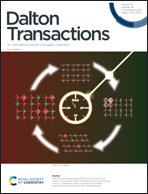Lithium selenometallates of triel elements, Li5MSe4 (M = Al and Ga), aliovalent doping and their ionic conductivity†
Abstract
Ternary selenometallates, Li5MSe4 (M = Al(I) and Ga(II)), have been synthesized for the first time through high temperature solid-state reactions combining elements and Li2Se in stoichiometric compositions. Li5MSe4 crystallizes in the P21/m space group, forming a pseudo-2D layer type structure with edge sharing LiSe4 and MSe4 tetrahedra along the a-axis. These layers are interleaved by octahedrally coordinated Li ions located in the interlayer space. AC impedance spectroscopy measurements yield room temperature ionic conductivities of 0.60 × 10−7 and 0.58 × 10−7 S cm−1 with calculated activation energies of 0.51 and 0.48 eV for I and II, respectively. An aliovalent substitution of Sn4+ in Li5MSe4 yields compositions of Li4.66Al0.82Sn0.22Se4 (III) and Li4.37Ga0.89Sn0.24Se4 (IV), which crystallize in the P21/m and P![[3 with combining macron]](https://www.rsc.org/images/entities/char_0033_0304.gif) m1 space groups, respectively. Sn-doped samples show an ∼5-fold increase in ionic conductivity, 3.37 × 10−7 S cm−1 and 2.4 × 10−7 S cm−1 with activation energies of 0.54 and 0.28 eV, respectively, for III and IV. The optical band gap values of the compounds are 3.65 and 3.2 eV for I and II, respectively, as measured by diffuse reflectance spectroscopy. Density functional theory (DFT) calculations predicted a major contribution from the Se 4p-states in forming the top of the valence band and strongly hybridized the Se 4p and ns orbitals of Al and Ga in forming the bottom of the conduction band with almost no contribution from the Li s-states near the Fermi level indicating their ionic interactions with the ligand.
m1 space groups, respectively. Sn-doped samples show an ∼5-fold increase in ionic conductivity, 3.37 × 10−7 S cm−1 and 2.4 × 10−7 S cm−1 with activation energies of 0.54 and 0.28 eV, respectively, for III and IV. The optical band gap values of the compounds are 3.65 and 3.2 eV for I and II, respectively, as measured by diffuse reflectance spectroscopy. Density functional theory (DFT) calculations predicted a major contribution from the Se 4p-states in forming the top of the valence band and strongly hybridized the Se 4p and ns orbitals of Al and Ga in forming the bottom of the conduction band with almost no contribution from the Li s-states near the Fermi level indicating their ionic interactions with the ligand.



 Please wait while we load your content...
Please wait while we load your content...